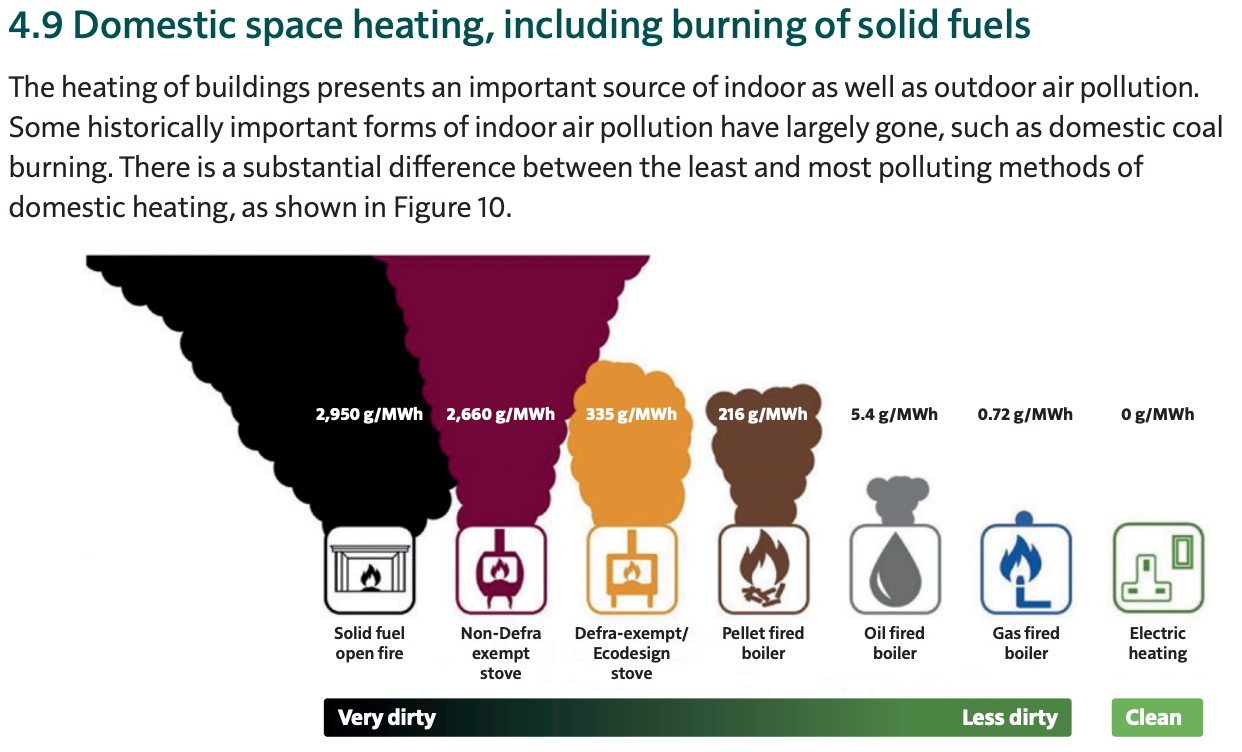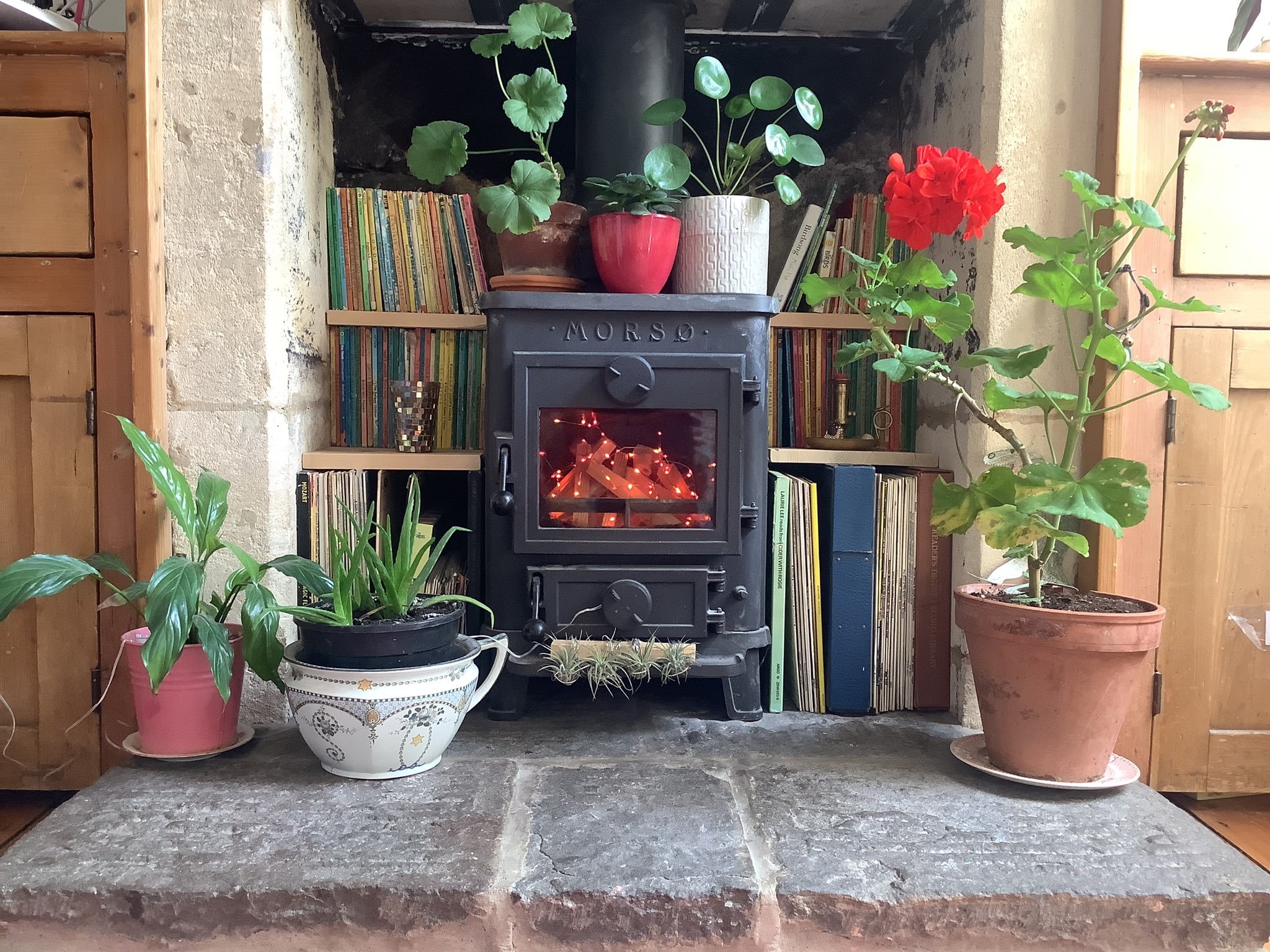Wood Burning
Our wood burning campaign
We’re calling on the Government to:
Phase out the sale of new wood stoves by 2027, and phase out the use of wood burners unless the only source of heat by 2032 at the latest.
Label wood burning stoves as harmful to better educate consumers.
Provide effective powers to local authorities to stop unlawful burning, with all wood burners registered with local authorities to enable enforcement.
Launch a public health campaign to raise awareness of the dangers of wood burning stoves and open fires.
Our wood burning group is made up of people from all over the UK who are concerned about this much-misunderstood source of air pollution. We are regularly in touch with MPs and government and always welcome new voices - together we are stronger!
What’s so bad about wood burning?
Domestic combustion is a major source of particulate matter
Even the most ‘eco-friendly’ wood burning stoves emit high levels of fine particle pollution (PM2.5). This report commissioned by Defra reveals that on an equivalent hourly operational basis, an Ecodesign stove is likely to emit six times the mass of PM2.5 than a diesel Euro 6 HGV (see figure 2 on page 18).
In the UK domestic combustion is one of the biggest sources of PM2.5. The term “domestic combustion” covers the burning of wood, coal, solid smokeless fuels, and fuels derived from waste such as coffee logs. Between 2009 and 2020 emissions of PM2.5 from domestic combustion rose by 36 per cent, largely due to a rise in emissions from the burning of wood. In recent years, most emissions from domestic combustion came from households burning wood indoors, which contributed 11 per cent of total PM2.5 emissions in 2023.
PM2.5 is one of the most problematic pollutants and has been associated with a range of health conditions, including decreased lung development and function, exacerbation of asthma, allergies, COPD (chronic obstructive pulmonary disorder), pulmonary fibrosis and an increased risk of lung cancer. It is also linked with increased morbidity and mortality. The World Health Organization has stated that there is no safe level of PM2.5.
The effect of wood burning on a neighbourhood
At Mums for Lungs we are regularly contacted by people affected by wood burning who feel powerless to act.
The negative physical and mental health effects of living near a household that burns can be significant. Many people feel trapped in their own homes because they can’t open windows or sit in their garden without breathing in fumes.
Even when those living in a Smoke Control Area make a complaint to their local authority, often nothing is done as the enforcement mechanism is not fit for purpose.
Local authority air quality monitors are usually sited next to busy roads and therefore do not take into account the spikes of air pollution that happen in neighbourhoods when people burn. These air pollution “hotspots” are a very little-known or acknowledged part of the wood burning problem.
This is why we need a public health campaign to raise awareness of the impacts of wood burning stoves and open fires.
Similarities between wood and tobacco smoke
Wood smoke contains most of the same carcinogens as tobacco smoke, including benzene and polycyclic aromatic hydrocarbons.
Research shows that wood smoke is more toxic than cigarette smoke. 15 per cent of lung cancers diagnosed in the UK develop in people who have never smoked, and a US Study found that using an indoor wood stove or fireplace increases women’s risk of developing lung cancer by 43 per cent compared with those who do not use wood heating.
The packaging of tobacco products has contained health warning messages and images for many years now, to raise awareness of the harmful effects of smoking with the public.
We want to see wood burning stoves labelled as harmful as well, to better educate consumers.
Burning wood is not carbon neutral
Many people think that burning wood is carbon neutral, because living trees absorb carbon dioxide (CO2) from the air and store the carbon within. But when wood is burned, the CO2 that was absorbed over the years that the tree was alive is released back into the atmosphere all at once, along with short-lived pollutants such as black carbon. Trees can be replanted, but it takes decades for those new trees to reabsorb the carbon that was emitted when their predecessors were burned.
Graph taken from Global Action Plan’s Relight My Fire report on the cost of wood burning.
Wood burning is expensive
The yearly cost of using a new, Defra compliant stove for 20 per cent of a household’s heat, including purchase & installation, is 24 per cent higher than running a typical gas boiler. Even when using an existing stove, the yearly cost is 15 per cent higher than gas.
In almost every scenario, it is cheaper to heat your home using a gas boiler or a heat pump, not to mention less polluting and more efficient.
What is the Government doing?
Ecodesign Regulations
From January 2022 all new stoves had to meet Ecodesign Regulations in the UK and EU. Ecodesign stoves meet tighter emissions standards than previously manufactured stoves, so any new stove installed will automatically be less polluting than an older one. However, the report mentioned above states that “despite the proposed Ecodesign Directive, domestic stoves will continue to make a substantial contribution to particulate emissions across Europe”.
Further to that, research from the European Environmental Bureau discovered that per GJ of energy, an EcoDesign stove is actually allowed to emit 60 times as much particulate matter as an old truck from 2006 and 750 times as much as a newer truck from 2014. This research was carried out under optimal laboratory conditions - which will produce better results than in real-life conditions.
Image from Professor Whitty’s report showing comparative emissions from heat sources
Chief Medical Officer Professor Chris Whitty’s 2022 air pollution report noted that Ecodesign wood burning stoves are several hundred times more polluting than gas central heating, and that “solid fuels are by far the most polluting method of domestic heating”.
We can conclude that Ecodesign stoves are not the clean air miracle they are being sold as.
“Burn Better”
The previous Government ruled out a ban on wood burning and instead preferred an educational approach. Their campaign to urge people to “burn better” did not go far enough. Many people now believe that as long as they do not burn wet wood, and sweep their chimney once a year, they are not contributing to the harmful emissions that neighbourhoods are subject to when solid fuels are burnt. However, as this 2025 Ricardo Energy and Environment report for Defra shows, for modern stoves (including a Blue Angel stove), PM2.5 emission factors are higher for dry wood than for seasoned wood.
Environmental Improvement Plan (EIP)
In January 2023 the previous Government published its Environmental Improvement Plan, the five-year update to the 25-year Environment Plan. To start work to meet the air pollution targets set out in the Environment Act, a plan was produced to reduce the amount of smoke that new stoves can emit in smoke control areas, from 5g of smoke per hour to 3g. Local authorities were to be instructed to consider using powers to issue on-the-spot civil penalties, ranging from £175 to £300.
However, these proposed changes were never made law, so were unfunded and unenforceable by local authorities. Prior to the change in government in Summer 2024, Defra said it was “preparing policies to tackle domestic emissions”. It remains to be seen whether a Labour government will step up on this issue. Defra are carrying out a rapid review of the Environment Improvement Plan and we look forward to the findings.
What can I do?
Stop burning wood if you have an alternative
Please don’t burn if you have another form of heating. Can you only burn on special occasions if you can’t stop completely?
If you’re thinking about installing a stove…please don’t! Take a look below at a few examples of alternative options.
Images of fireplace alternatives, L to R: Matt White, Natalie Martin, Lily Hughes, @salbots
We run a social media campaign called #FireplaceFlip, to show that fireplaces or stoves can be beautiful without the flames. We’ve been sent some excellent ideas, including a stove that has been turned into a terrarium! If you have an alternative way to heat your home and don’t need to burn wood, your fireplace can still be a focal point, in an emission-free way.
Write to the media about wood burning
Interior magazines, television programmes and social media are full of images of living rooms with roaring fires or beautifully styled fireplaces and stoves. A stove is portrayed as a coveted purchase, and there is usually no awareness or acknowledgement of the amount of air pollution given off by burning wood and smokeless fuel.
If you read a newspaper or magazine or watch a TV programme that promotes wood stoves as a design feature, please bring our campaign to the attention of the magazine editor or broadcaster. We have a template letter that you can use to email them.
If you see burning portrayed as a good thing on social media posts, please leave a quick comment to explain that wood burning gives off a lot of pollution that is damaging our health.
Write to your local authority about wood burning
We write to all London and Greater Manchester councils every Autumn to ask them to raise awareness of the dangers of wood burning and to ask all residents not to use their stoves or fires unless they are the only source of heat. You can use our template letter to contact your council if you’d like to do similar.
Order our wood burning flyer
We have a flyer that you can order for free or download and print yourself. People across the country are using them to raise awareness of the impacts of wood burning.











